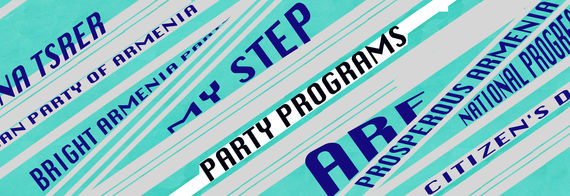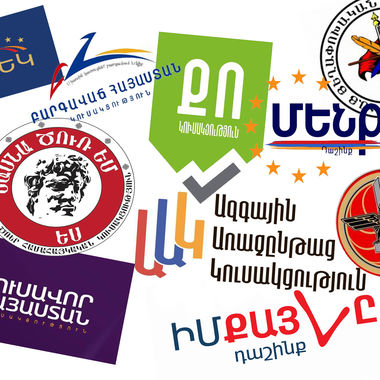Mon Dec 03 2018 · 4 min read
These Four MPs Left the Republican Caucus to Run Under Pashinyan’s Banner

By Harout Manougian

On April 17, 2018, when Armenia’s National Assembly elected Serzh Sargsyan as Prime Minister in anticipation of the transition from a presidential to parliamentary form of government, all 58 members of the Republican Party of Armenia (RPA) caucus were present and voted in favor. That unanimity would not last long. Now, four of those members of parliament (MPs) are running against their old RPA companions as part of Nikol Pashinyan’s My Step Alliance.
The first to break ranks was Feliks Tsolakyan. A former Governor of Shirak marz (province), Tsolakyan was elected to the National Assembly in the 2017 parliamentary election under the open-list (“ratingayin”) system by collecting enough personal votes in the 11th electoral district (coterminous with Shirak marz). Though not officially an RPA party member, he was listed as an Independent on the Republican candidate list and given the 180th spot on their closed-list national roster in 2017. (For more background on Armenia’s electoral system, read more here.)
On May 1, 2018, thirteen months after that election and following Sargsyan’s resignation, Tsolakyan was the only member of the RPA caucus to vote for Nikol Pashinyan to become Prime Minister (PM). That day was the first attempt to elect Pashinyan as PM; it failed 45-56. It was not until a week later, on May 8, that the Republican Party instructed some of its MPs to vote in favor of Pashinyan and the motion passed. It wasn’t until June that he officially left the Republican caucus.
Tsolakyan was appointed Minister of Emergency Situations on October 3, 2018, for which he had to step down from his seat in parliament. The ministerial position had been vacated after executive appointees belonging to the Prosperous Armenia Party (PAP) and Armenian Revolutionary Federation (ARF) were dismissed en masse, following a vote in parliament supported by those parties that could have delayed the calling of fresh elections. Those elections will take place on December 9 and Tsolakyan now occupies the 42nd spot on the closed-list national roster for Pashinyan’s My Step Alliance – and one of their ratingayin candidates for Shirak. He is still listed as having no party membership.
Though the RPA technically ran as a party rather than an alliance in 2017, their candidate roster and, subsequently, their parliamentary caucus (or faction) included not only Independents but also members of other minor parties. Shirak Torosyan, a member of the Powerful Homeland Party (it sounds more normal in Armenian: Hzor Hayrenik), is one of them and our second defector.
Torosyan has been getting elected off the RPA national list since 2007. In 2017, he was ranked #31. Born in Javakhk, his focus has been in the area of foreign relations. As mentioned, on May 8, the RPA designated several of its MPs to vote for Pashinyan to become Prime Minister. Torosyan was not one of them but he did so anyway. To discipline him, the RPA considered removing him as MP. Instead, he left the RPA caucus on May 29 and kept his seat. He has now joined the My Step Alliance and is listed #43 on their national list, still listed as a Powerful Homeland Party member.
The last two MPs to “cross the aisle” both represent ethnic minorities and both also voted for Pashinyan on May 8. Arsen Mikhaylov and Knyaz Hasanov represent the Assyrian and Kurdish communities, respectively. They were both elected as Independents on the RPA ticket in 2017 when a new procedure requiring representation of ethnic minorities first came into effect. Those rules were under review over the summer by the Prime Minister’s Special Commission on Electoral Reform. During one of their sessions, Hasanov expressed that MPs representing ethnic minorities should sit with the ruling party. Mikhaylov agrees.
The Commission eventually recommended amendments to the Electoral Code that would have changed the way ethnic minority representation in parliament was approached but those changes did not pass when introduced in the National Assembly in the fall. As it stands, under the same rules as 2017 (you can read more about them here), the party that gets to elect MPs representing the Assyrian and Kurdish communities is very difficult to predict as it depends on the relative ratios of the parties’ seat counts. Mikhaylov and Hasanov, now running under the My Step Alliance, do have better odds at keeping their seats in the event of a landslide victory for Pashinyan.
The MP representing Armenia’s Yazidi community, Rustam Makhmudyan, voted against Pashinyan on May 8. He was elected in 2017 as an Independent member of the RPA caucus. He is not running for re-election with any party this time around.
The MP representing Armenia’s Russian community, Tatyana Mikaelyan, is a member of the Prosperous Armenia Party, with whom she is seeking re-election on December 9.
more on elections

The Parties, the Platforms
Nine political parties and two coalition forces are running for a seat in the country’s National Assembly. EVN Report present's the main provisions and principles (translated from the original Armenian) from the campaign programs of those political forces.
Primer: Snap Parliamentary Elections 2018
EVN Report presents the biographies of the top ten candidates of the 11 political parties and coalition of parties that are participating in the snap parliamentary elections to be held on December 9.
Women Continue to Sit on the Sidelines in Armenian Politics
By Gohar Abrahamyan
Despite the fact that more than 50 percent of Armenia’s population are women, only one party has entrusted the number one slot on its electoral list to a woman. Gohar Abrahamyan takes a look at which forces have the most women on their lists and why women’s presence alongside men is not the result of good will and remains problematic.




